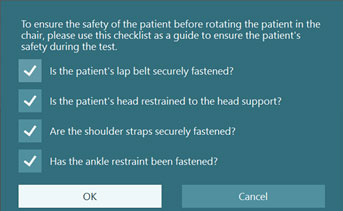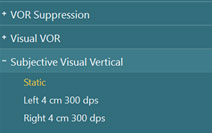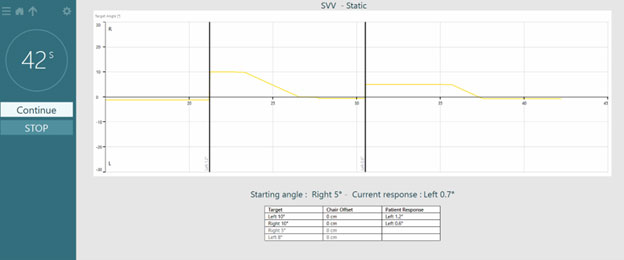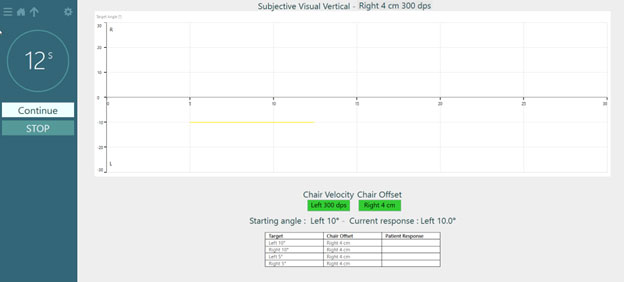VisualEyes™, Orion Support
Available Training
-
How to perform the Sinusoidal Harmonic Acceleration (SHA) test
-
How to perform the Velocity Step test
-
How to perform the Vestibulo-Ocular Reflex (VOR) Suppression test
-
How to use VisualEyes™ EyeSeeCam
-
How to perform the Dynamic Visual Acuity (DVA) test
-
How to perform the Advanced Dix-Hallpike test
-
How to perform the Supine Roll test
-
How to perform the Lempert (BBQ) Roll
-
How to perform the Gufoni Maneuver
-
How to perform the Epley Maneuver
-
How to perform the Dix-Hallpike test
-
How to perform the Brandt-Daroff Exercise
-
How to perform the Anterior Semont Maneuver
-
How to perform the Posterior Semont Maneuver
-
How to perform the Caloric test
-
How to perform the Optokinetic Nystagmus (OKN) test
-
How to perform the Gaze test
-
How to perform the Saccade test
-
How to perform Positional Nystagmus testing
-
How to perform the Spontaneous Nystagmus test
-
How to perform the Smooth Pursuit test
-
How to perform calibration procedures
-
How to perform the Lateral Head Roll test
-
How to perform VORTEQ™ vHIT
-
How to perform Saccadometry
-
How to perform the Active Head Rotation test
-
How to perform the Ocular Counter Roll (OCR) test
-
How to use the Research Module
-
How to perform the Gaze Stabilization Test (GST)
-
How to perform Cervical Gaze testing
-
How to perform the Functional Vision Head Impulse Test (fvHIT™)
-
How to use keyboard shortcuts in VisualEyes™
-
How to perform Pupillometry
-
How to perform Self-Paced Saccades
-
How to perform the Smooth Pursuit Neck Torsion (SPNT) test
-
How to set up and troubleshoot monitors for oculomotor and optotype tests
How to perform the Subjective Visual Vertical (SVV) test
The Orion Comprehensive rotary chair will provide you with license capabilities to perform static SVV tests. In addition to the static SVV, if you have an Orion Auto-Traverse rotary chair, you can perform dynamic off-axis SVV tests. It is also possible to license static SVV to use without a rotational chair using your examination table/chair and television screen if you have a completely dark room. This guide will be focused on the gold standard testing protocols which require a rotational chair with a room enclosure.
Patient safety
Before beginning any tests in the Orion rotary chairs, please ensure proper patient safety by checking the items in the pop-up message below. In addition to this list, ensure that the goggles are unplugged from the chair and removed from the booth for SVV tests.

Figure 1 - Rotary chair patient safety message
Performing the test
To begin testing, select SVV from your drop-down test menu.

Figure 2 - Test menu for SVV
Provide the remote control for laser line adjusment to the patient inside of the booth and ensure that the lanyard is securely attached to the patient’s wrist, or alternatively, to the seat belt of the chair. This is especially important for the dynamic SVV tests when the chair will be rotating.

Figure 3 - Patient with remote control securely fastened
The patient is instructed to press the arrows on the remote control to move the laser line until the line is perceived to be vertical.

Figure 4 - SVV patient remote control
Static SVV test
For the static SVV test, the patient will be seated inside the enclosed rotary chair booth with the door securely closed and the booth light turned off to ensure a proper vision-free test environment. The goggles do not need to be worn by the patient for this test. The chair will be stationary for the static SVV test. Select the ‘static’ test from the test menu. When the patient is ready to begin the test, press start on the test screen to initiate the laser line inside the booth and begin the trials.

Figure 5 - Static SVV test screen
As the patient adjusts the laser line with the remote control, the examiner will see the target angle on the test screen (depicted by the yellow line) change in the graph. When the patient indicates that they are satisfied with the adjusted laser line and feel it is in vertical alignment, press continue to move to the next trial. The patient’s response angle will appear in the table below the graph upon pressing continue. A minimum of 4 trials is recommended. More trials can be added as desired. This can be configured in protocol management.
Dynamic SVV test
If you have the Auto-Traverse chair, you will also be able to perform dynamic off-axis SVV tests. For the dynamic SVV test, the patient will be seated inside the enclosed rotary chair booth with the door securely closed and the booth light turned off. Be sure to remove the goggles from the booth before initiating a dynamic SVV test. Select the left or right 4 cm 300 dps test from the test menu. When the patient is ready to begin the test and has been given appropriate instructions, press start on the test screen. This will initiate chair rotation. As the chair velocity ramps up to reach target velocity (approximately 70 sec), the following count-down message will be displayed in the test window.

Figure 6 - Dynamic SVV count-down display
After the desired velocity has been reached, the chair will then move off axis 4cm to the specified direction.

Figure 7 - Auto-Traverse chair positioned to 4cm right for dynamic test
The chair offset and chair velocity indicators in the software will turn green when ready.

Figure 8 - Dynamic SVV test screen with chair at desired velocity and offset
When the chair has achieved desired velocity and offset, press continue to initiate the laser line inside the booth and begin the trials. As the patient adjusts the laser line with the remote control, the examiner will see the target angle on the test screen (depicted by the yellow line) change in the graph. When the patient indicates that they are satisfied with the adjusted laser line and feel it is in vertical alignment, press continue to move to the next trial. The patient’s response angle will appear in the table below the graph upon pressing continue.
When the final trial is complete, the chair will move back to a centered position and begin to slow down. The following message will appear in the test screen. This will take several seconds.

Figure 9 - Dynamic SVV chair stopping message
A minimum of 4 trials for each dynamic off-axis chair position (left and right 4cm) is recommended. It is also possible to perform a combined left, center, and right dynamic SVV protocol. This can be configured in protocol management.
Results
After each subtest group of trials is complete, the patient’s responses will be displayed in a graph on the summary screen.

Figure 10 - Completed test summary screen
There are no threshold levels available for static and dynamic SVV tests.
For further assistance, please refer to the Instructions for Use and Additional Information manuals, which can be accessed from the question mark icon on the main screen in the VisualEyes™ software.
Presenter

